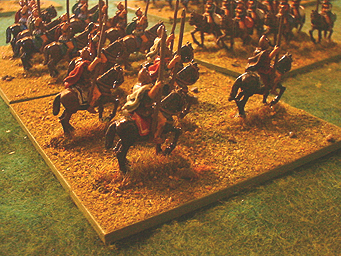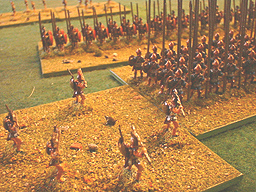
Thracian light cavalry.
This page last modified: 3 May, 2002
This is one of the few armies I own that I did not paint myself. The core of it used to be Graeme Ward's, who stopped playing with it after the demise of WRG 7th edition and eventually sold it to me in early 2002 when I was developing AoT; the army featured in the first public demonstration of the rules in Christchurch during Easter 2002.

Thracian light cavalry.
The figures are all by Naismith. I really like them - they are 'true' 15mm, and the men are properly proportioned - not with the oversized heads and hands and bulging limbs of most manufacturers' figures. Most of the figures are also 'at rest' - I am not a fan of 'active' figures. The vast majority of the time soldiers in a battle are not swinging thie swords or galloping aroound, but resting.
These Thracian light horse, or prodromoi, are armed with a single spear, the doru, as seems to have become the norm during the 4th century BC to judge from depictions of such men in Thracian tombs, rather than a pair of javelins as seems to have been more usual in the 5th century. Such Thracian mercenaries played a prominent part on the left wing in Alexander's early battles in Asia, being ably commanded by Parmenio.

Peltasts supporting the left flank of the phalanx.
It is my contention that Alexander did not use his Greek merceanries in the role of classical peltasts hurling javelins like the men shown above, but rather as spear-armed "Iphikratean hoplites"; see here for the reasons. Alas, nobody does a suitable range of figures. Nethertheless, these men could substitute javelins for spear if the need arose to become such skirmishers, as Antigonos seems to have done in the last decades of the 4th century BC.
The pike-armed phalanx could also swap their 'spear' for javelins in a similar manner; though I bleive that as time went on, only the best trained men retained this capability; see here for this.